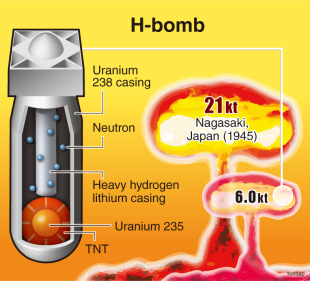Nuclear weapons are classified into atomic, neutron and hydrogen bombs. Among them, hydrogen bombs, also known as thermonuclear bombs, are known to be the most powerful due to their unique structure that expresses explosive power. 
Unlike atomic bombs that derive their energy from nuclear fission – splitting of atoms — hydrogen bombs obtain their explosive power from both nuclear fission and fusion, the process of forming a heavier nucleus from two lighter ones such as the nuclei of the hydrogen isotopes tritium or deuterium.
While fission bombs can have as small as 1 kiloton of explosive power — North Korea’s 2013 nuclear test was known to have 6 to 7 kilotons — hydrogen bombs’ explosive power ranges in the hundreds of kilotons.
The hydrogen bomb’s basic principle is the idea that different parts of a thermonuclear weapon can be chained together in stages. A thermonuclear weapon uses the energy from a nuclear fission reaction to set off another nuclear fusion reaction, binding the nuclei of small atoms and releasing more energy.
The hydrogen bombs can be made small enough to fit in a ballistic missile warhead or an artillery shell that can be carried. The U. S. first developed the hydrogen bombs in 1952 and the former Soviet Union developed them in 1953. But they have never been used in practice.
By Yeo Jun-suk (jasonyeo@heraldcorp.com)

